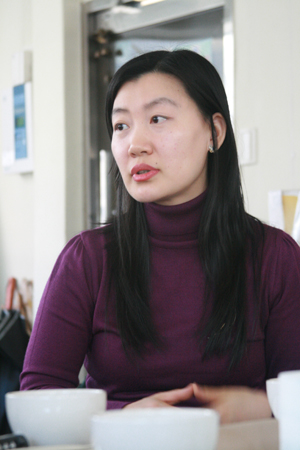CAH: Explain what Han-ji industrial art is.
Shin: First of all, any art using Korean paper is considered Han-ji industrial art. It includes making masks using dissolved paper or cutting off and attaching paper over and over again or twisting paper into a string and so on. Many people already know the cutting of and attachment of paper art because they are interested in it. However, twisting paper into a string named ‘Ji-seung’ industrial art is not known to many people. I do this part of Han-ji industrial art.
First, I make twine using Han-ji. In case of color, I can choose among many dyes in natural colors. I twist a single-ply of thread into a double twine one by one. Few people know about it, I also did not much about it until I needed to know.
CAH: How did you experience this industrial art?
Shin: Orginally, I had learned metal craft. Then I met a woman Cho, Eun-sil, who learned Han-ji industrial art from her great-grandfather, who had been an intangible cultural asset for 30 years. When we go home, she always twisted Han-ji. Sitting beside her, I would touch it with half curiosity, half interest. In addition, I was getting interested in it more and more, because I had lost confidence of metal crafting. One day, I grasped a Han-ji braid; I felt an unexplainable emotion that the braid did not come unraveled in my hands. From that point, Han-ji industrial art, especially ‘Ji-seung’ art, became one of the most important things in my life.
CAH: What are the most difficult things or aspects of this?
Shin: People ask me if I can earn money through this. The answer is absolutely no for now. However, I started doing it knowing the hardships I will face, while I raise understanding about ‘Ji-seung’ art. Another thing is the negative sight of people. I was quite embarrassed with their attitude. I think that they would be unfamiliar with my art, which is making clothes or corsets using ‘Ji-seung’ art. I do not want to keep only one tradition, but I wanted to attempt something new. With the desire of an artist, I want to show people how beautiful Han-ji art can be. It was a reason for participating in the 2006 ‘WOW Art Award Show’.
CAH: When you stay in New Zealand for festival, what did you feel?
Shin: When judges saw the clothes which were made of Han-ji, they were very surprised. Paper does not seem strong enough to make clothes. However, when this paper is twisted, the braid is not cut off easily and is strengthen. The judges seemed to find this characteristic and understand it exactly. In addition, New Zealand considers old traditions to be very important, therefore they appreciated the ‘Ji-seung’ art that was handed down from the ‘Chosun’ period, and that monks mainly made ‘Han-ji’ works.
I participated in this show with passion. However, I was more impressed that the people of New Zealand regard cultural traditions as very important. On the contrary, Koreans usually pass over the many remains, which are collected over thousands years in museums. So, did I. Now, I am proud of our tradition. I will never lose my courage.

CAH: Do you have any plans of letting people know about this industrial arts?
Shin: I want to show my ‘Ji-seong’ Art to a broad range of people. One of the reasons, I participated in the ‘WOW Art Award Show’ was to inform people of ‘Ji-seung’ Art. To inform others about this art, I first had to plan to hold a ‘surprising fashion show’ this year, because many people do not know even what it is, how it looks. I tried to make clothes through Han-ji, and the clothes can show all techniques of ‘Ji-seung’ Art. If I have a ‘surprising fashion show’ on the street, many people will gaze once. Then I will explain that it is made of Korean paper, Han-ji’.
Another plan is more international. In Untied States of America (USA), many new art styles and type takes place continuously. I desire to make ‘Ji-seung’ Art famous. I think our art is practical. Other countries consider the cultural remains of a skill that is over 100 years old to be very important. I think about it positively. I want to show this art to all of the people of the world.


